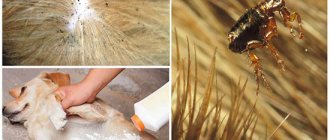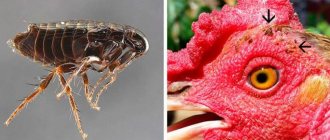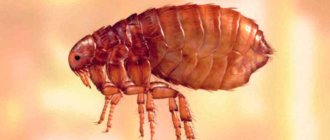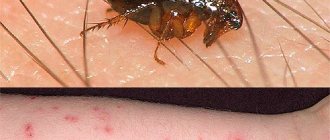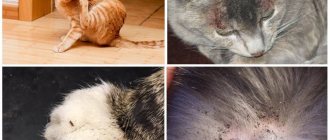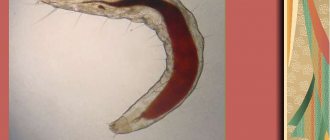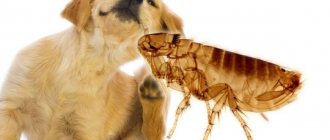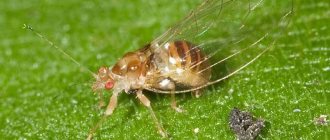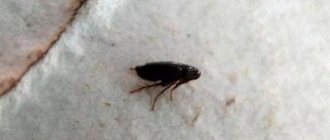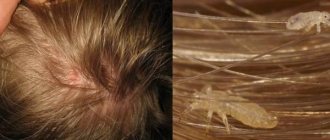Save article:
Fleas in cats are parasitic insects that often appear in pets. This brings an unpleasant sensation and anxiety to the animal, because the flea, being a bloodsucker, bites through its delicate skin. Infection with cat fleas occurs mainly through direct contact with a carrier, but they can enter the house from the hallway and from the street, on outer clothing or the soles of a person’s shoes. Therefore, fleas appear on both domestic cats and walking cats.
When a flea gets on an animal's fur, it multiplies very quickly, and the cat feels fine at first. One female lays 8–20 eggs daily, from which larvae hatch after 7–12 days. Interestingly, a cat can carry up to two hundred parasites at the same time. Moreover, each flea sucks a large volume of blood from it: it can exceed 20 times its mass.
Features of cat fleas
The flea that can be found on a cat is the closest relative of rat and dog fleas. But despite this, its appearance is quite specific. Although the subtle differences between flea species are only accessible to specialists, it is useful to know the appearance of cat fleas. These parasites can transmit many dangerous diseases by biting a person.
It is mainly this type of flea that attacks cats, other animals and people in both rural and urban areas. While other types of fleas “remain faithful” to one “master”. Interestingly, if cat fleas settle on a rat, they will soon completely displace these same insects, which parasitize only on rodents.
There are no anesthetic enzymes in the saliva of a cat flea, so its bite is very painful.
What do pests look like?
The flea that parasitizes cats looks like an extremely small insect of a dark brown, almost black color. She can literally appear for a second in the animal’s fur and hide there again. The size of the parasite's body directly depends on its age and can range from 0.8 to 4 mm, the average length is 2–3 mm.
This type of insect is devoid of wings, but its powerful hind legs more than compensate for their absence - they allow it to disappear from sight with lightning speed, jumping to a height of 30 cm in any direction. The body of the parasite is flattened on the sides, which gives it the following advantages:
- It's hard to crush a flea
- it is convenient for her to move in her owner’s fur,
- During the jump, air resistance is almost not noticeable.
Video: cat flea under a microscope
It is worth noting that cat fleas and lice belonging to different types of insects can annoy cats. Moreover, it is almost impossible to meet them on one representative of the cat family. The louse lives in the fur constantly, but the flea only jumps on your furry pet while feeding. And lice cannot change their source of food, while a flea does this easily and with pleasure.
The dimensions of a cat flea are smaller than those of a rat or dog flea. In addition, in a rat parasite, the end of the body is slightly raised, while in a dog parasite, the head is larger. True, it is very difficult to notice all these differences by eye, because the parasites sit in one place only during the bite, and their small size interferes with a thorough study of the flea.
Photo gallery: different types of fleas
The cat flea parasitizes not only “its” animal, but also other mammals
The human flea most often lives near where a person sleeps
Rat fleas are carriers of many deadly infections
The dog flea's body is covered with bristles, and its legs have hooks that help it stay on the dog while moving.
How to tell if your cat has fleas
At the very beginning of the appearance of fleas, they may be invisible to the eye, but already at this time signs appear that should alert the owner. So, the cat begins to twitch sharply and immediately itch, while literally biting into the fur and skin. Under the fur you can see scratches from scratching. The following experiment will help identify the presence of parasites:
- The cat is placed on a white sheet of paper.
- They begin to comb the animal.
- If small black-brown pellets appear on the white surface, this is flea excrement. To further check, drop water on them - they will take on a brownish-red hue.
Observing them live will help you to finally make sure that your pet has parasites. To do this, move the cat's fur with a fine comb in several places and you will be able to see the moving flea or its feces, which look like black dust or sand.
The cat flea development cycle involves eggs, larvae and pupae being laid and developing outside the animal's fur, so only adult fleas bother the cat
During the process of breeding, female parasites do not lay eggs, but literally shoot them as far as possible in different directions. This gives more larvae a chance of survival if conditions are unfavorable.
Reasons for appearance
A comfortable temperature for the life of parasitic insects is from 20 to 30 degrees. Therefore, they can live in the basements of apartment buildings, and from there move into the entrances and apartments. Consequently, not only street animals, but also those living with people can “catch” these parasites.
The main ways fleas appear in domestic cats are:
- introduction of larvae or adults from the street on clothing and shoes;
- transmission from another mammal that has these parasites (dogs, mice, rats, etc.). It is worth noting that when living outside the city and keeping livestock, the infection rate increases tenfold.
Important: parasitic insects can live on all pets, so without treatment (or if it is not carried out regularly), cross-infection is possible. They do not live on humans, but they can bite.
Are these parasites transmitted to other animals or people?
Cat fleas, unlike other types of these parasites, are quite unpretentious in food, and they can be called lovers of warm-blooded mammals, and not just cats. Therefore, bloodsuckers from a cat can easily jump to a dog or person. Features of the lifestyle do not at all imply that parasites must live permanently on the host. Their larvae do not need blood at all to develop.
Humans can also become victims of cat fleas. To do this, it is enough to be near a cat infected with parasites or even near its litter. In addition, bloodsuckers can attack you:
- near an enclosure where other animals live;
- in a neglected apartment;
- in the entrance, where homeless animals are rarely cleaned and often spend the night;
- on farms, mainly rabbit ones;
- in places where rodents are common - in a field, meadow, near a hayloft or granary;
- in the forest near the habitat of wild animals: badger, fox, etc.
Small black grains in the animal's fur (flea feces) mean that your cat is being attacked by blood-sucking parasites
What do you need to know?
Each parasite lives on average three months, but some varieties can live up to two years (taking into account all stages of development). Those of them that live in Russian latitudes are able to fall into a numb state when unfavorable conditions occur and return to activity if necessary. In the absence of living organisms for a long time, they are able to wait a long time, clinging to the skin as soon as the opportunity arises. Most common questions:
- Where do fleas come from in humans? In most cases, they get into the house by catching on the paws of a passing dog or cat or on the legs of the person himself. Most types of domestic fleas live on pets, since human temperatures are not comfortable for them, but they also bite people;
- Why do fleas appear? The desire for blood is their natural need, so to avoid problems, you should follow simple hygiene rules and regularly treat your pets with protective drugs;
- Where do fleas start? In the wild, they live in tall grasses, bushes and other similar places, and cling to the first warm-blooded animals they come across. If left untreated, insects multiply in the fur of domestic animals; if the population expands, the carpet, underground, sheets, and furniture become infected.
That's why it's better to prevent your home from getting infested with these parasites than to deal with it later. Anti-flea collars, flea drops and other similar means of protection will help protect your pet, and at the same time your home, from the penetration of unpleasant blood-sucking insects. Protective measures will make it possible to avoid other threats that these creatures carry within themselves.
What is the danger of cat fleas?
Loss of blood in microscopic quantities is the least of the problems that can be expected from a flea bite. There are also other dangers threatening due to this parasite.
For cats
In addition to the fact that a flea bite is painful for the animal, spoils its mood and causes anxiety, it can cause other problems. So, in a cat:
- Fungal and bacterial dermatitis may appear;
- an allergy to the saliva and feces of the parasite occurs;
- can get worms;
- due to the decomposition of flea excrement, chronic otitis may develop;
- due to the bite and scratching, the mucous membranes of the eyes and nose become inflamed;
- anemia may appear caused by mycoplasmas (hemobartonellosis), which without treatment causes death;
- tularemia can develop (appears due to the bacterium Francisella tularensis). The disease manifests itself in severe fever, damage to the lymph nodes and general intoxication. The result: the death of the animal.
For kittens, pregnant and lactating cats
If kittens are recently born and are feeding on a lot of parasites, within a few days the animals may develop severe anemia. As a result, little fluffies lose their appetite, feel weak, and their body temperature drops. As a result, the death of babies is possible.
Read more on the topic in our article: How to safely remove fleas from a kitten at home.
Fleas are also very dangerous for a pregnant cat, because many infections transmitted through their saliva cause malformations of the embryos or even miscarriage. But even without becoming infected, an animal with severe blood loss due to multiple bites can lose its babies. A nursing cat infected with fleas will certainly pass them on to her kittens; this also applies to infections.
Nursing and pregnant cats are at particular risk of flea infestation due to the health risks for kittens
For people
For a person, a cat flea bite is no less dangerous than for his furry pets. The parasite can infect you through saliva:
- anthrax;
- scarlet fever, also called pseudotuberculosis;
- dipilidosis, which provokes problems with the gastrointestinal tract;
- pulicosis (a rash accompanied by redness of the skin and itching);
- brucellosis, which causes severe fever and affects almost all internal organs;
- creeping erythema (under the influence of this infection, lymphocytes and skin are damaged, and necrosis of the latter occurs);
- worms;
- endemic typhus.
Cat flea bites are not only unpleasant, but can also cause many diseases.
How to remove fleas from a cat
Before removing fleas, the home is thoroughly vacuumed, paying special attention to the animal’s bedding and other favorite places. After this, the cat's bedding is washed at high temperature and treated with a flea insecticide. The substance is also used to cover the floor and walls at a height of up to 1.5 m. After this, you should start ridding the animal itself of parasites. There are many tools for this that differ in their effectiveness and application features.
Always be wary of cheap products, especially drops, since they are almost 100% guaranteed to contain permethrin. Although this agrochemical kills fleas, it is also extremely toxic to cats. An animal can only be saved in a veterinary clinic. But even in such conditions, a third of cats die.
Sprays
Aerosols, according to veterinarians, are one of the most effective remedies for fleas, but they must be used carefully, since an overdose can poison the cat. During treatment, a protective collar is put on the animal, which should remain on it for up to half an hour after the procedure to avoid licking off the product. It is advisable for the person carrying out the treatment to wear a respirator and rubber gloves. Due to the high concentration of the active substance, the spray is best used for disinsection of rugs and rooms where the cat lives. Popular means:
- Frontline,
- Hartz,
- Celandine,
- Leopard.
Flea sprays must be used carefully; an overdose can cause poisoning to the animal.
Collars
Flea collars are very loved by cat owners because they work from 2 to 7 months and do not require any effort to combat parasites. But, although this product is very effective, a chemical-based collar is unsafe for the animal, since the cat is constantly inhaling the toxic substance with which the item is treated. A herbal collar is not as effective, but is safer.
A flea and tick collar is a very effective remedy.
If you have more than one cat, collars cannot be used. By biting or chewing even a small piece, the animal can become seriously poisoned.
Drops
Drops are the most popular flea remedy. This is explained by their effectiveness, relative safety and ease of use. To use the drug, you should open the capsule and squeeze the product onto the withers, first spreading the fur.
Flea drops are the best option for protecting your animal from these parasites.
The drops will rid your pet of almost all types of parasites for up to a month. Then the procedure is repeated. However, the product should be chosen very carefully, since some of its ingredients can harm the health of the pet, gradually accumulating in the body. The most famous drops:
- Leopard,
- Frontline,
- Rolf,
- Advantage et al.
Powders and shampoos
Powders are among the safest products for cats. During processing, you should wear rubber gloves and rub the substance into the animal’s skin with your hands, spreading the fur with a comb. After treatment, the cat is combed well so that the powder is in the down and not on the surface of the coat.
The shampoo is effective if there are few parasites. Products can be natural or with added chemicals. The second type of product is only suitable for washing adult cats. The main disadvantage is that even with thorough rinsing, a certain amount of the product will remain on the fur, which means that the pet will swallow it when licking it. And some products can cause dermatitis. It is permissible to rid kittens of fleas only with the help of natural shampoo.
Flea shampoos are effective only if the animal has few parasites
Folk remedies
If you are afraid of harming the animal with chemicals or you cannot use them on it, folk remedies will come to the rescue.
Tar soap
This soap can be purchased at a pharmacy or household chemical store. It has antiparasitic, anti-inflammatory and other beneficial properties, therefore it is effective against fleas. When using it, the animal is moistened with water, thoroughly soaped and rinsed thoroughly.
Tar soap is a universal remedy for getting rid of parasites in different animals.
Scallop
Oddly enough, a regular comb will help get rid of a small number of fleas. This is explained by the fact that parasites do not lay eggs in the animal’s fur, but jump there to search for food. How to carry out the procedure:
- Use a fine comb to comb fleas out of the fur.
- The animal should be washed with anti-parasitic shampoo.
- Then you need to do a general cleaning of the home - vacuum everything, wash the floors, wash the animal’s bedding, treat all surfaces with insecticidal preparations at a height of up to 1.5 m.
A regular comb will help rid your cat of a small number of fleas.
Sagebrush
Wormwood is good for repelling fleas, so it should be used as a preventative after getting rid of parasites. To do this, after first treating the cat for fleas, dried or fresh wormwood is laid out at the entrance to the house.
You can also use a decoction of wormwood for cleaning floors:
- Take 3 heaping tablespoons of dry chopped herbs.
- Boil it in half a liter of water in a steam bath for 10 minutes.
- After this, the product is filtered and diluted in 5 liters of water, which is used to wash the floor.
Pine or spruce sawdust
Fleas cannot stand the smell of pine needles, so sawdust from it can be stuffed into an animal’s pillow or sprinkled under the bedding.
Celandine
This plant is poisonous in large doses, so it is effective against fleas. For processing, make a decoction of celandine:
- Twenty grams of the dried plant are mixed with 2 glasses of water.
- Cook for 5–10 minutes after boiling.
- The product is then cooled, filtered and rubbed into the animal’s fur.
During the procedure, the parasites will begin to jump off the pet, so it is better to carry out such actions in an empty basin, which is placed in a bathtub filled with water.
Many antiparasitic drugs contain celandine extract.
Contacting specialists
Your veterinarian may recommend two types of flea control: tablets and vaccinations. The injection helps to completely forget about the existence of these parasites for six months. But the tablets last for about 1 month, and the effect of their use appears only 3 weeks after the start of use.
Features of flea removal in pregnant or lactating cats
Removing parasites from cats expecting or nursing offspring is especially important. The life of the kittens directly depends on the health of the mother. The wrong choice of insecticides can lead to miscarriage, congenital pathologies of babies, or their death immediately after birth. Before removing fleas from a pregnant or lactating cat, you need to:
- Be sure to consult a veterinarian, where a suitable drug will be selected for your pet.
- Vacuum the house and wash the floors.
- Wash, dry and treat the animal's bedding with insecticide, then ventilate it for 3 days.
- Before using any product, comb the cat thoroughly with a comb. First, use a comb with sparse teeth, and then with frequent ones.
The following drops are optimal for pregnant cats:
- Stronghold,
- Advantage-40,
- Frontline.
They are as harmless as possible to the animal. When choosing a drug, make sure that it does not contain organophosphates and permethrin, which can cause severe poisoning of the cat.
Flea injections are not given to pregnant animals, because they are dangerous for future offspring; sprays are also undesirable to use due to severe toxicity. It is strictly forbidden to use Comfortis tablets to remove fleas from a pregnant cat.
Symptoms of infection
Veterinarians identify certain signs that indicate the presence of bloodsuckers. Symptoms directly depend on the extent of spread. There are 3 main stages:
- Initial, which can be detected by a very attentive owner during a thorough examination of the pet’s fur. The only obvious sign will be more frequent scratching than usual.
- The second stage is characterized by increased nervousness, sleep disturbances, and lack of appetite. The cat begins to gnaw something out of the skin, biting itself at the same time. Bloodsuckers are clearly visible on the hairline, especially at its base.
- The third stage is manifested by a clear deterioration in health, weight loss, and refusal to eat. Severe ulcers on the skin are noticeable, and allergic dermatitis begins. Hair falls out in clumps, the coat becomes very thin to the touch and becomes dull.
Any stage of the disease serves as a signal to begin active action. Timely treatment will help eliminate symptoms, help your pet, and prevent the spread of insects throughout the house or apartment.
Preventing fleas in cats
If you have just gotten rid of annoying parasites or want to avoid their appearance altogether, you need to take a number of measures:
- Bathe your cat regularly with flea-proof shampoo and wash her bedding frequently.
- Periodically inspect the animal for parasites.
- It is not advisable to let your pet go outside, where he can meet an infected animal and pick up fleas from it. After a walk, wash your cat with anti-parasitic shampoo.
- Put a flea collar on your cat.
- Give the animal injections against blood-sucking parasites at the required intervals.

